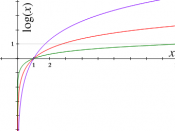If one took the time to contemplate the functions used casually everyday in classrooms around the world, one may come to the realization that these functions have revolutionized life. Without the ability to multiply, divide, rise to a power, and take a root of, people would be completely ignorant of how of what makes the earth go around. These are not just mathematical functions; their magnitude could be appraised as phenomenal. The logarithm, being one of the most perplexing of these phenomenons taken for granted, was discovered by mathematicians John Napier and Henry Briggs in the early fifteenth century. Napier felt the need to explain his brilliant discovery in the form of a book: Mirifici logarithmorum canonis description. Logarithms were originally required for astronomical purposes because of the unavoidable computations of large numbers. Thus the logarithm significantly reduced time wasted on other functions. Since the inventions of the pocket calculator, which is known for its ability to make such large computations involving large numbers instantaneously, the log is no longer required for time saving purposes; today they are most useful in graphic analysis of non-linear relationships.
The logarithm is also still in common usage in such fields as engineering, business, applied sciences such as a biology, chemistry, and physics. When a student posed the question of how logarithms were used in everyday life to "Dr. Math", he was as perplexed as I and could only conjure up this for an answer:
"It depends on what you mean by "daily life". I have never,
for example, used logarithms to help balance my checkbook :^)
But any time you need to convert multiplications to additions,
they can be useful. For example, if you get a loan at a
bank that has continuous interest (they all do), if...


